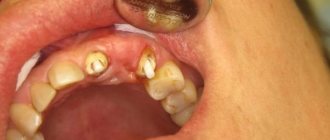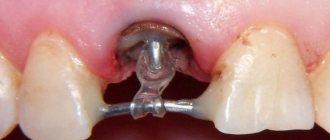Features Indications Contraindications Materials and manufacturers Installation Possible complications Timing What to do in case of loss Care after surgery Care after surgery
Implant prosthetics is the most physiological way to restore missing teeth. The essence of the method is that an artificial tooth root is implanted into the gum, on top of which an orthopedic structure (crown, bridge) is installed. But in order for the prosthetic system to look natural, fit tightly to the gum, and be firmly fixed to the implant, special superstructures are used - a gum former and an abutment.
The gum former is not always installed during implantation. In case of complete edentia of the jaw, when one-stage technologies with immediate loading of the prosthesis are used to restore the dentition, it is not used. Installation of this superstructure is necessary in a two-stage protocol. Without it, it is impossible to achieve the correct gingival contour so that the prosthesis looks natural and aesthetically pleasing.
With one-stage techniques, the stage with the installation of this element is often skipped. In these cases, one-component implants are usually used, which are immediately loaded with a prosthesis. If two-component models are used, and the installation of a temporary prosthesis is performed on day 3
, the implantologist sometimes installs a superstructure to preserve the gingival margin.
This is especially true when it comes to restoring front teeth.
. Here, attention is paid more to aesthetics, and achieving a beautiful smile without using this superstructure is almost impossible.
Appearance of the gum former
The gum former looks like a thick screw with a small thread pitch. On its upper part there is a thick head. The diameter and shape of the upper surface of the head exactly corresponds to the base of the future tooth, and the lower part of the head, accordingly, has the shape of the top of an already installed artificial root. It turns out that the gum former exactly repeats the shape of the teeth and roots in their normal state.
The pin of the gum former has a thread that serves to screw it tightly into the artificial tooth root.
Gum formers are made individually and only for one specific tooth. This device is designed to form a hole in the gum where the artificial tooth will be located. The success of the installation of the gum former determines how tightly the artificial tooth will adhere to the gum. This is a very important point. The fact is that if the gum does not fit tightly around the tooth, then food will get into the gap. It is not so easy to remove it from there, and therefore gum inflammation is possible.
Reiter
Functions of the healing abutment
Installation of a gum former is one of the stages of tooth prosthetics. With the help of a former, the gums acquire a natural anatomical shape, correct contour and healthy appearance, which gives the dentition an aesthetic appearance.
What is a healing abutment
A healing abutment is a cylindrical screw made of titanium alloy, ceramic or plastic. The size of the former head, its diameter and height, depends on the future location of the dental implant and its parameters, the thickness of the soft tissues, and the anatomical features of the dental arch.
Installation of a high-quality former in dental surgery is characterized by the following results:
- no discomfort in the oral cavity;
- flexibility and functionality in operation;
- there is no irritation, rejection, allergic reactions or inflammatory processes.
Non-oxidizing titanium is considered the optimal material for the manufacture of dental structures; it has hypoallergenic properties. When replacing the frontal area of the dentition, preference is given to zirconium implants. Implantation of the front teeth is carried out simultaneously; a rod, a dense tooth cover and a temporary crown are installed in place of the lost tooth in one day. With this approach to prosthetics, the structure does not show through the gums and does not cause unnecessary discomfort to the patient when talking and smiling.
Call our clinic and find out more
The gum former is one of four types of abutments (structures that are connecting links between the prosthesis and the implanted implant - an artificial root). They are manufactured serially in factories or individually, by computer modeling using precise measurements.
In prosthetics, implants from both Russian and foreign manufacturers are used. Products from Adin, Bicon, Implantium, Biohorizons, Niko, Astra Tec and others have proven themselves well. Shapers from different manufacturers differ in the composition of the material, production technology, shape and type of thread.
Installation during implantation
If the decision is made to install implants in one step, then the gum former is inserted into the artificial root on the same day. In this case, a non-dismountable implant design is used. The simple method is considered more gentle and is usually used in prosthetics of front teeth.
To achieve a better result, extend the life of the prosthesis, correct gum formation and tissue correction, the stages of implantation are not combined. The installation of a gum former is an intermediate link between the implantation of an artificial root and the installation of an abutment for subsequent prosthetics.
This manipulation involves opening the implant head by excision of soft tissue, cleaning the surface from overgrown bone, unscrewing the plug head with a torque wrench, and installing the former. During the process, the doctor, if necessary, carries out correction and modeling of the gum contour. Visually installed formers look like metal hemp caps protruding several millimeters above the gum surface.
Typically, the implantation former is installed within three to six months after implantation, the timing depends on the gum healing process. But no later than two to three weeks before the end of the healing phase. Osseointegration occurs faster in the lower jaw. In the upper jaw, it will take a little longer for the implant to heal. If there is an urgent need to reduce the duration of prosthetics, the latest developments and technologies are used that accelerate the osseointegration of the implant into the bone tissue.
The procedure for installing a gum former is not pleasant, but for the patient it is absolutely painless; all manipulations are carried out under local anesthesia. In the future, the doctor prescribes analgesics to relieve painful and unpleasant sensations that may appear during the healing and restoration of the gums. During premedication and after installation, the patient takes antibiotics to prevent the development of inflammatory processes. An experienced implant dentist usually spends about half an hour installing the former.
How long to wear a shaper
As a rule, the patient walks with a shaper for at least 8-12 days. The dentist sets the deadline, taking into account the condition of the tissues, the complexity of the prosthetics and the individual characteristics of the body. After the expiration of the period, the former is replaced with a temporary or permanent crown.
While the patient is wearing the former, the dental technician is busy making dentures, having previously taken measurements and impressions. To make crowns and try them on, the head of the former is removed and then put back.
Complications after implantation of the former
Proper preoperative preparation, compliance with sterile conditions during implantation, the use of antiseptic solutions and careful care of the oral cavity after surgery reduce the risk of complications to a minimum. Before starting prosthetics, the gums should be treated.
Alarming symptoms of possible postoperative complications may include:
- - bleeding gums, suture dehiscence;
- - continuous painful sensations;
- - hyperthermia, swelling, inflammation of the gums under the installed former, acute sinusitis, otitis media;
- - allergic reactions;
- - numbness of the cheek, tongue, lip due to injury to nerve endings, difficulty swallowing;
- — suspicion of implant rejection (its loosening is felt).
If such complaints occur, you should make an unscheduled appointment with a doctor as soon as possible. As first aid for bleeding, it is recommended to treat the oral cavity with an antiseptic (0.2% chlorhexidine solution), cover the bleeding site with a sterile cotton swab, and then apply cold to the gums. Painful sensations are symptomatically relieved with analgesics; if allergies occur, antihistamines are taken.
In any case, it is necessary to consult with a doctor who will determine the causes of complications after the installation of formers, prescribe effective treatment, or decide to remove the former or the implant as a whole.
The healing abutment is not installed correctly
Unfortunately, when installing the shaper, mistakes can be made, which can cause problems with wearing the structure and subsequent prosthetics. Most often, the shaper falls out (poor quality thread, incorrectly selected size) or unscrews spontaneously. In the first case, you should urgently contact an implantologist to install a new former, if you feel that it has just begun to loosen - it is possible to tighten the connection.
If the shaper looks installed crookedly, do not be alarmed. The main thing is that the implant is positioned correctly, and problems with inclination will be solved by an angled abutment, which will be installed instead of the shaper.
Some patients experience accelerated growth of tissue around the tooth socket - hyperplasia. It is eliminated surgically, the “extra” mucous membrane is excised. Overgrowth/covering of the gum by the abutment can be mistakenly confused with swelling of the gums, so you should tell your doctor about the sensations and condition of the gums. If the cap “sinks” under the gum, then most likely the former will need to be reinstalled or replaced.
Recommendations: how to care, hygiene, nutrition
The placement of a gum abutment is a surgical procedure, so the healing process will be directly related to following oral care recommendations. On the first day after implantation, you must stop smoking, and during the first hours, do not eat, drink coffee, or carbonated drinks. For the first day or two, it is advisable to eat ground food at normal temperature; after meals, rinse your mouth with herbal decoctions (chamomile, sage) or boiled water. For the first couple of weeks after surgery, it is better to limit heavy physical activity and visits to the sauna or bathhouse. The medications prescribed by the doctor are taken according to the schedule throughout the entire recovery period, and the schedule of visits to the implantologist is strictly observed.
Caring for the installed gum former involves regularly removing accumulated plaque. Teeth brushing is carried out twice a day, using a brush with soft bristles, floss or irrigator, so as not to injure the mucous membrane in the area of the sutures. Recommendations for care will be given by the dental hygienist from the clinic where the former will be installed on the implanted implant. He will also select a preventative toothpaste taking into account the condition of the mucous membrane and gum tissue.
Shaper during pregnancy
Pregnancy is a relative contraindication for prosthetics; dental operations should be performed after consultation with an obstetrician-gynecologist observing the patient. It is best to install a gum former in the second trimester of pregnancy, select medications for healing and prevent complications, taking into account the woman’s position.
Heal former price
The cost of a gum former along with installation (as of the beginning of 2015) varies on average from 1,500 to 4,500 rubles. The difference in price is due to the different costs of the materials from which the former is made, the quality of the alloy, the level of professionalism of dentists, as well as the pricing policy and location of individual clinics in Moscow. The final cost of the procedure for installing a gum former will depend on the complexity and volume of work performed.
In details
What is the gum abutment made of?
The best material for making a gum former is titanium. This metal is very light and extremely durable. In an aggressive environment, and the oral cavity is such for metal, titanium does not oxidize at all. In essence, this would be an ideal option for such a product, if not for one “but”.
The fact is that titanium is visible through the gum. For those people whose gums are visible when they smile, this option is not suitable. They prefer to install a healing abutment made of zirconium. This material does not have this drawback.
Methods
The surgical method is chosen by the doctor based on the gum parameters, width and thickness. Plastic surgery is performed using:
- using your own tissues from the intervention area;
- transplantation of a donor flap from the hard palate;
- application of collagen matrices or membranes.
Membranes are a progressive method of restoration. It differs from others in its high predictability, minimally invasiveness and short rehabilitation period.
Abutment and healing abutment
The technology of implanting artificial teeth along with gum formers allows the use of abutments. This is a completely different device, designed for installation in an artificial root after the gums have formed. It is installed in place of the gum former and serves to fit the tooth more tightly into the root.
The top of the abutment has a completely different shape than the healing abutment. It is made individually for each tooth. There are several types of abutments: temporary, standard, angled, cast and custom. These devices are made of ceramic, titanium, gold, plastic or special alloys.
Classification
In dentistry, it is customary to classify gum formers according to quality of manufacture and cost.
The economy class includes gum formers produced by Adin, Alpha Bio, MIS, Iterum (Israel), Bicon (USA), Implantium (Korea, USA).
Business class products are produced by the only German company in the world, Xive. Manufacturers of premium gum holders are Straumann (Switzerland), Astra tech (Sweden), Nico, Ankylos, Impro, Semandos (Germany), Nobel Biocare (USA).
Even though gum formers from one company are suitable for installing implants from other companies, dentists still recommend using all products from the same manufacturer.
What manufacturers are there?
All orthopedic systems can be divided into several classes: premium, business and economy. Gum formers are divided according to the same principle; they are manufactured by the same companies that produce implants. The cost of designs from different brands can vary significantly; usually the doctor tries to select all the necessary components from one company; working with them is much easier and simpler.
Gum former Straumann (Switzerland), Astra Tech (Sweden), Nobel (USA) are premium products.
Products of the Xive brand (Germany) can be classified as business class designs. Gum former osstem (South Korea), Bicon (USA), MIS (Israel) - economy class systems.
When choosing the necessary elements for implantation, the specialists of the A-medic clinic take into account the wishes of the patients and their financial capabilities. We do not impose expensive goods, first of all, thinking about you.
Installation sequence
The length of time required to prepare for the placement of a healing abutment may vary. This depends on the extent of preparatory measures. Sometimes this process lasts for six months, and sometimes only for a few days. The operation itself does not last long. During a standard installation, it is done in the following sequence:
- - local anesthesia is given;
- — an incision is made in soft tissue to gain access to the fastening;
- - excess soft tissue is cut out;
- — the plug is removed from the implant;
- — manually or with a ratchet, screw the former into the root.
- - stitches are placed on the cuts.
Preparation for dental implantation
Preparation is considered one of the most important stages, along with the actual implantation. At this stage, the type of upcoming prosthetics is determined, suitable implants are selected, the patient’s health condition is studied, and potential contraindications to surgery are identified.
Preparation includes several processes:
- examination and consultation with a dentist;
- assessment of the volume and quality of bone tissue;
- tests and examinations - CT scan, x-ray, blood test;
- examination and consultation with specialized specialists (carried out in the presence of chronic diseases);
- choice of implantation technique (single-stage, two-stage), selection of implants and prostheses;
- sanitation of the oral cavity, treatment of all dental diseases so that in the future they do not become a source of infection and cause implant rejection.
The result of the operation and the successful implantation of the implant depend on proper preparation.
How long do you have to wear a gum former?
After installation of the former, the gums usually heal within a week, but this does not happen in all patients. In any case, only the doctor determines the readiness of the oral cavity for surgery.
Separately, it is necessary to say about bleeding from the gums after installing the former. For most patients, this ends on the second or third day. However, for many, the ichor oozes for much longer. You shouldn’t be afraid of this, since these are simply individual characteristics of the body in terms of blood clotting. Statistics show that you have to wear a gum former for no longer than two weeks. After this, the former is unscrewed to take an impression for the prosthesis.
The essence of the formation of the hole is the flow of soft tissues around the gum former. Of course, they cannot adhere to the surface of the former, but they adhere to it very tightly. As a rule, this process occurs evenly along the entire circumference of the former. Only in rare cases does the overgrowth occur unevenly. In this case, surgical intervention is required.
When can you get prosthetics?
The final stage of prosthetics occurs after complete healing of the gums around the former, i.e. in 1-4 weeks. The patient should not be bothered by pain, swelling or bleeding. If the tissue has recovered sufficiently, the final stage of implantation begins. At the preliminary appointment, the implantologist takes impressions of the jaws, which will help the specialist make a crown. The patient may also be referred for an orthopantomogram (OPTG) to see how the osseointegration of the metal implant is progressing. At the last stage, the former is unscrewed, an abutment is installed into the implant, and the final element is the crown.
Possible complications after the installation of a gum former
Unfortunately, the process of gum formation can be complicated by considerable troubles. Most often they are caused by a doctor’s error, less often by the characteristics of the patient’s body.
The doctor’s mistake is also considered to be the fact that he did not find out whether the patient is susceptible to an allergic reaction to painkillers. If such a reaction exists, then after installing the former in the patient’s oral cavity, an inflammatory process may begin. It should be said that the shaper itself cannot cause an allergic reaction.
Sometimes after installing the shaper, the pain does not disappear, but, on the contrary, intensifies. This is a sign of inflammation of the soft tissues or a violation of the tightness of the sutures. In this case, the patient is prescribed antibiotics and new sutures are placed. Sometimes swelling of the cheek occurs after surgery. This is not an anomaly, and the swelling soon goes away on its own.
It also happens that the former puts too much pressure on the gum, causing it to become inflamed. In this case, all the blame lies with the doctor, because he incorrectly calculated the size of the shaper. Such a former has to be replaced with another. It is very bad if the shaper begins to wobble a few days after installation. This can happen from a loose fit into the root or a loose fit of the artificial root into the bone. A loose root may be due to insufficient bone density. In this case, the doctor prescribes calcium for use. If the density of the bone tissue is high, and the former wobbles along with the root, it means that the body has not accepted the foreign body and rejects it. Soon an inflammatory process will begin under the root. To avoid this, the former is removed along with the root.
Sometimes the gums bleed for a long time under the stitches, although the stitches were applied correctly. There is only one reason for this: the patient’s weak blood clotting ability. In this case, you should definitely consult a doctor.
It is very important to know that if you do not follow all the doctor's recommendations, then in the postoperative period you may experience such unpleasant things as tumors, toothache, neck pain or sore throat and ear.
What complications can you encounter?
Immediately after the procedure, as the anesthesia begins to wear off, patients often feel pain. There may be bleeding and swelling at the gum incision site. In the normal course of tissue restoration, these symptoms should be observed for no more than 7 days, their intensity should gradually decrease. If the swelling increases and the bleeding intensifies, then you need to urgently consult a dentist, as this may indicate the development of various complications. You should also visit a dentist if the pain persists for more than a week.
Sign up for a consultation
What can happen if the healing abutment is not installed correctly?
Correct installation of the gum former is a guarantee that the implantation of an artificial tooth will be completed successfully because the socket for the prosthesis will be formed as needed. If the shaper is not installed accurately, then the hole will not be formed as it should be.
If the root is planted too deep into the bone, then the former will not be installed correctly. Soon it will begin to wobble and then fall out. This happens because bone tissue will begin to grow on the root and displace the former. In such a situation, the doctor cuts off the growth of bone tissue, and the structure will soon strengthen itself.
If the former suddenly falls out of the root, you need to immediately screw it into place yourself and see a doctor as quickly as possible. You cannot delay your visit, because the hole begins to overgrow very quickly. A late visit means that you will have to start installing the former again, which means cutting the gum again.
It also happens that the soft gum tissue completely covers the entire former. This is the result of a doctor’s mistake who incorrectly calculated the size of the shaper. In this case, you have to install a new, higher former. An incorrectly installed gum former that is too high causes discomfort when eating. This situation also requires replacing the former with a lower one.
Purpose
Prosthetics consists of several stages that solve certain problems:
- Increasing jaw bone mass;
- implantation of an artificial root;
- installation of the former;
- abutment placement;
- installation of an implant crown.
Increasing bone mass is necessary when there is a large loss of the maxillofacial region. If teeth are missing for a long time, atrophy of periodontal and jaw tissue occurs. Therefore, before installing implants, the necessary mass of bone and gums is restored. Then an artificial root is implanted and the gum contour is formed.
Indications for use of the shaper are installation of any type of implants. After tooth extraction or loss, periodontal tissue gradually undergoes changes. The hole becomes overgrown, the bone sags, and the contour becomes invisible. Metabolic processes in the tissues around the fallen molar slow down; it is impossible to implant an artificial tooth under such conditions.
The gum tissue will not be able to tightly wrap around the artificial unit, and pieces of food will accumulate in the space between the gum and the implant. As a result, an inflammatory process will develop in the mucous tissues, the gums will become loose, and the artificial tooth will not be able to stay in the jaw. To avoid troubles, use a gum former.
After tooth loss or extraction, bone and gum tissue lose their volume due to lack of chewing load.
The temporary abutment forms a gum cap, thereby helping the jaw tissue to accept an artificial replacement for the lost tooth. The gingival cuff is a clear edge of the gum and elastic gum tissue. The gums acquire the necessary volume and fullness. The abutment is installed for a certain time and then removed. Instead, an implant is implanted.
Is it possible to do without installing a temporary abutment? If you install an implant on an unprepared jaw, part of the metal root will be visible. That is, the aesthetics of the smile will suffer greatly. The gum former is dispensed with when making a removable denture to restore lost teeth. The prosthesis is formed to imitate gums, so there is no need to install an abutment.
How to care for your mouth after a gum former is installed?
After installing the gum former, you need to take care of your oral cavity in full, but in a gentle manner. The first thing we recommend is to change your hard toothbrush to a soft one. In this case, when brushing your teeth, you will not disturb the gums, and most importantly, the stitches. At this time, you need to brush your teeth without any pressure on the brush. If you want, you don’t need to clean them, but gently iron them. If the former suddenly falls out while brushing your teeth or eating, you should screw it back into place and immediately go to the doctor. Along with brushing your teeth, it is recommended to rinse your mouth with a saturated saline solution several times a day during the postoperative period. It is best to use sea or iodized salt. This procedure successfully prevents the occurrence of inflammatory processes.
A solution of hydrogen peroxide, tincture of calendula flowers, a decoction of echinacea root, a mixture of honey and salt, and some essential oils have similar properties.
Contraindications
It is prohibited to install the gum former when:
- Inflammatory lesions in the oral cavity;
- pregnancy;
- tuberculosis;
- cancerous tumors;
- type 1 diabetes;
- viral disease;
- high temperature.
Pregnant women are advised to wait to install metal pins because microsurgery is performed using anesthesia. Medicines can harm the fetus, even cause miscarriage.
Also, implants cannot be installed if there are anatomical defects in the jaw structure. In this case, preliminary plastic surgery to restore the maxillofacial region may be required. Only after this can the pin be implanted and the abutment installed.
Advice for pregnant women
In case of emergency, dental implantation can be done during pregnancy, but there are strict restrictions. So, this is strictly forbidden to do this in the first and third trimester, but in the second trimester it is possible. In this case, it is necessary to take into account the likelihood that after installing the gum former, the patient will have to take medications. This is not at all desirable for the fetus. The second point is that when installing a gum former, local anesthesia is used, and this will certainly affect the condition of the fetus. If it is possible to postpone implantation until the baby is born, then it is better to do just that.
Differences from abutment
Some patients confuse the healing abutment with the abutment. It can actually be used in implant placement to expand gums in a one-step procedure where a temporary crown and temporary abutment are placed. But this is not its main purpose.
The healing abutment is always installed temporarily. It is used to create a natural depression for further installation of an abutment and adjusting the shape of the gums for a permanent crown.
The abutment is designed to fix the crown. It screws into a titanium rod.
How expensive is implantation?
In conclusion, let’s say a few words about the cost of dental implantation. The cost of this operation largely depends not on the cost of dental labor, but on the cost of the materials from which the implants are made. In addition, real prestige and the manufacturer’s own self-esteem bring their own adjustments to pricing.
Also, the price depends on the class of implants; the higher it is, the higher the price. The cost of implants from European manufacturers is much higher than that of their American and Australian counterparts.
The most inexpensive implants currently are Israeli ones.
The importance of sufficient gum volume during implantation
- Aesthetics . During implantation, not only the success of installing the implant itself is taken into account, but also the appearance of the structure relative to the dentition. Installation of an artificial root should not interfere with the fixation of the crown, prosthesis, or interfere with neighboring teeth. In this case, the aesthetic gingival contour must be recreated.
- Functionality . Soft tissues provide nutrition to the bone structure of the jaw and support implant structures. Therefore, even before installing implants, the doctor analyzes the volume and condition of the gums and decides whether augmentation is required.
- Prevention of rejection . A healthy mucous membrane that forms around the implant protects the structure from plaque and bacterial penetration, and reduces the risk of peri-implantitis.
Stages
The operation is performed within 30-60 minutes. If collagen membranes are used, the time is reduced to 10-15 minutes .
Preparation
The oral cavity is disinfected. If necessary, the doctor limits the surgical site from the rest of the mucosa.
Anesthesia
Infiltration or conduction anesthesia with nerve block is used. Painkillers and anesthetics approved by an allergist are used.
Plastic
Incisions are made in the gums (if the operation is performed simultaneously with implantation, no incisions are made). Depending on the clinical picture, local tissue is used to form the gum, a flap of the required size is applied, or a matrix is used.
Seams
Application of surgical sutures.










